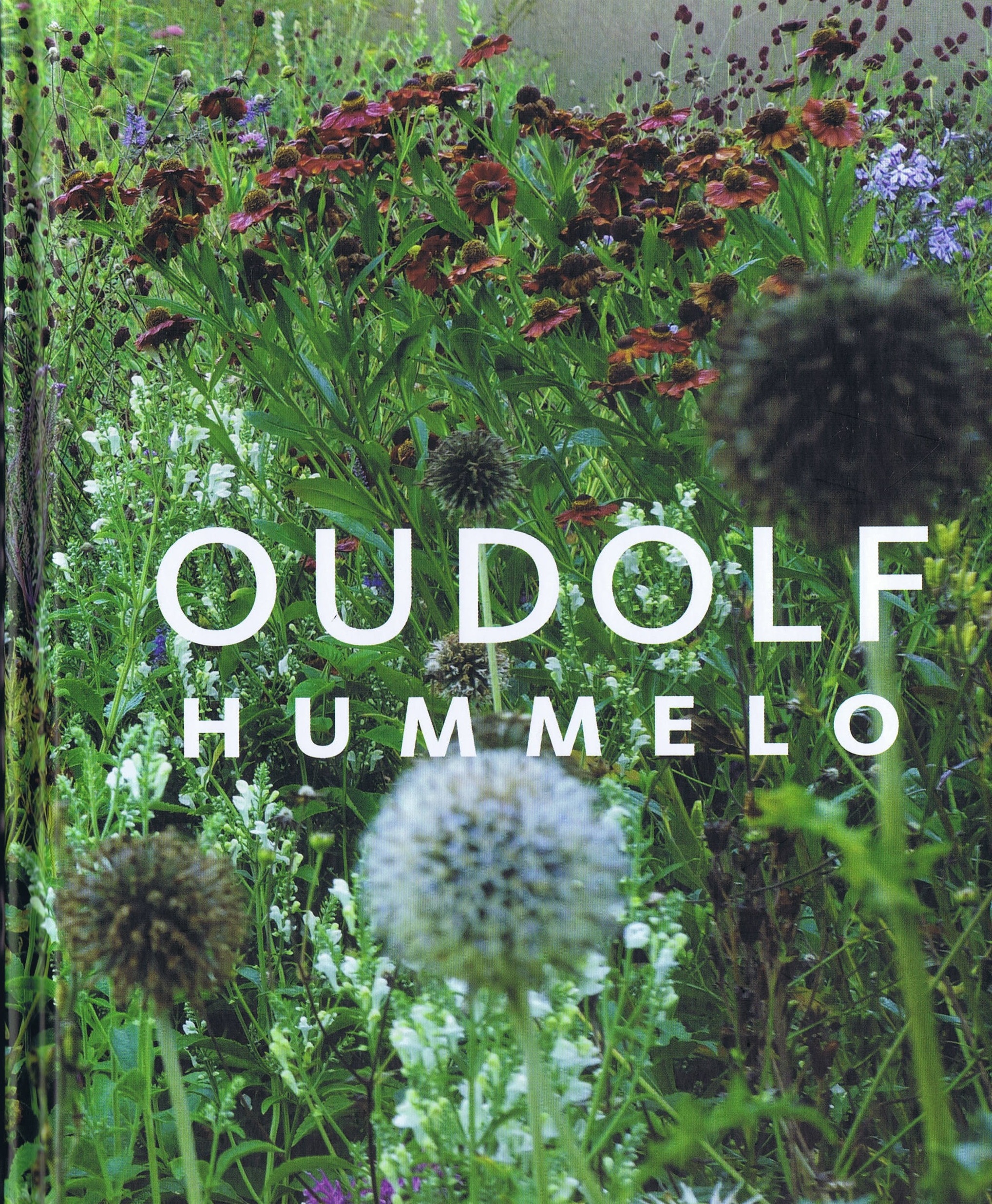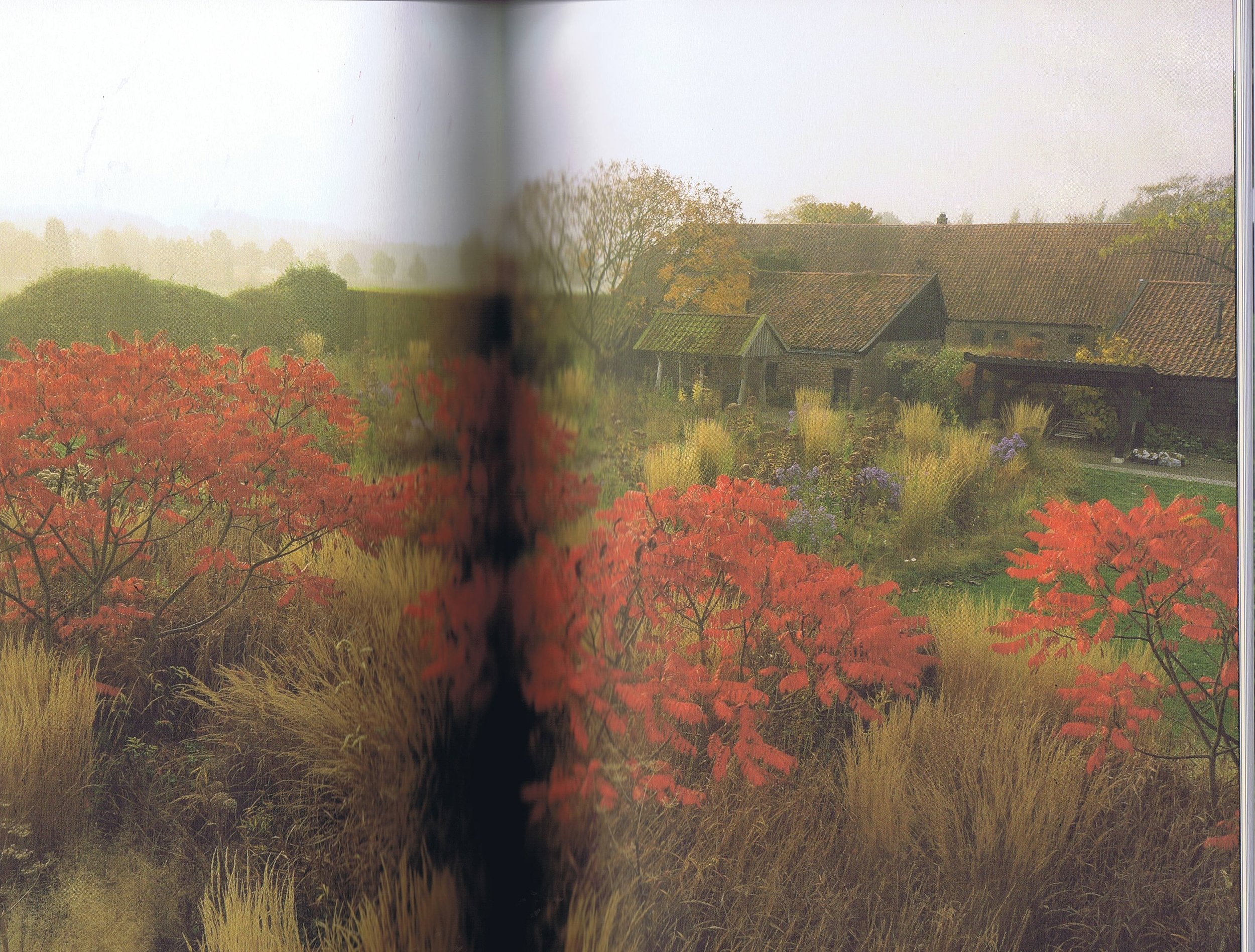Book Review: Oudolf Hummelo by Piet Oudolf and Noel Kingsbury
 Four years after the pictorial reference Landscapes in Landscapes (2011), the Monacelli Press recently issued Oudolf Hummelo written in part to commemorate Piet Oudolf's seventieth birthday and place the garden designer himself through a biographical and cultural prism. The book's hardcover format is rather unconventional for its subject because gardening books are often lavish coffee table tableau; instead what we have in our hands is the size of a hardcover fiction. Weighing at 2.8 pounds, Oudolf Hummelo is hardly the light paperback one slips into the travel bag. It reads easily at a relaxing pace without the overwrought drily tone typical of biographical genre. Despite being marketed as a biography, the book is more an examination of personal influences that shaped Piet Oudolf's career as a plantsman and plant designer. The way Noel Kingsbury and Piet Oudolf have chronicled the people and places makes for a more compelling story than the plants and gardens themselves as they had been in their previous books.
Four years after the pictorial reference Landscapes in Landscapes (2011), the Monacelli Press recently issued Oudolf Hummelo written in part to commemorate Piet Oudolf's seventieth birthday and place the garden designer himself through a biographical and cultural prism. The book's hardcover format is rather unconventional for its subject because gardening books are often lavish coffee table tableau; instead what we have in our hands is the size of a hardcover fiction. Weighing at 2.8 pounds, Oudolf Hummelo is hardly the light paperback one slips into the travel bag. It reads easily at a relaxing pace without the overwrought drily tone typical of biographical genre. Despite being marketed as a biography, the book is more an examination of personal influences that shaped Piet Oudolf's career as a plantsman and plant designer. The way Noel Kingsbury and Piet Oudolf have chronicled the people and places makes for a more compelling story than the plants and gardens themselves as they had been in their previous books.
By nature, the Dutch are a pragmatic, stoic lot especially for people who faced the inevitable task of carving out a country below sea level. Piet Oudolf is no different from his fellow country people - in temperament he comes across reticent and studious, (having met him and Anja once at the University of Pennsylvania's landscape architecture lecture program a few years ago), but warm and personable in good company. The Dutch talent for land reclamation extends to recreating beautiful gardens and landscapes, and Oudolf is one of the numerous practitioners within that community.
Behind each creative individual is another who holds the fort, keeping things organized and in order, and the book makes it clear that Anja Oudolf is integral to the operation. Piet and Anja's relationship, professional and personal, itself is not unusual in the gardening world where couples have kept enterprises afloat creatively and economically. Purchasing Hummelo in its decrepit state tested the mettle of the Oudolfs - their financial subsistence was for a year, forcing the couple to depend on Anja's cut-flower business for the first few years while Piet renovated the house and built up the nursery. At the same their two young sons had to be brought up. As Piet's work took him overseas, Anja assumed the helm of running the nursery, greeting visitors, and managing the staff and sales. Her outgoing demeanor was an effective foil for Piet's reticent nature.
When Piet and Anja began their garden design business, they did not benefit from having nurseries that grew their desired plants. The only option was to produce or breed their own, but it was a wonderful excuse for their trips to United Kingdom and eastern Europe where the Oudolfs developed long lasting relationships with plantspeople like Beth Chatto and Ernest Pagels. For several years, Piet systematically selected garden plants that still circulate in the nursery trade; among his successes were Salvia verticillata 'Purple Rain', which spurred the Oudolfs to sow and evaluate plants from seedlings, a richer hued Astrantia 'Claret', and Echinacea purpurea 'Fatal Attraction' distinguished in its dark pink flowers and black stems. Although plant breeding now has taken a backseat to garden design, new plants still materialize from time to time. One to emerge recently is Actaea 'Queen of Sheba', a probable hybrid between A. ramosa 'Atropurpurea' and A. dahurica. As Noel points out, the twin talents of garden design and plant breeding is more infrequent than people are led to believe, and Piet Oudolf stands out precisely in this aspect.
Notable plantspeople, landscape architects, and garden designers are acknowledged throughout the course of the book. It is evident that northern Europe informally formed a progressive horticultural 'salon' when the naturalistic garden movement was beginning to bubble. One key player of Piet's planting style evolution was Henk Gerristen whose garden Priona made with his partner Anton Schlepers gave Piet the confidence to become more liberated, spontaneous. Noel quotes Piet saying: 'Henk was guiding the planting into a natural setting. When we started to talk, I was trying to develop planting design and not really getting it. I found what I was doing was not spontaneous enough.'
Piet Oudolf gradually transcended the rather parochial world of garden design onto the international platform, in part due to high profile projects like New York City's High Line (James Corner Field Operations and Diller Scofidio + Renfro,) and the Chicago's Millennium Park's Lurie Garden (with Gustafson Guthrie Nichol). The latter enjoys a rare privilege in its endowment that accounts for the costs of having the designer return for continual evaluation. Jennifer Drozd, the former Director and Chief Horticulturist, had corresponded regularly with Piet about planting over the years. Perhaps the most symbolic gesture of Piet's devotion to Lurie is his introduction of Salvia x sylvestris 'Lurie', which horticulturist Laura Ekasetya describes 'being close to 'Dear Anja', but pink with white center. Oudolf's planting commission for the Lurie Garden marked a turning point in which he was able to see firsthand some of the North American prairie perennials outside of Chicago. Therefore he not only changed some of his planting in the Lurie plan, but also incorporated more of these perennials in his subsequent designs.
Oudolf's entrance into the wider 'cultural landscape' fortuitously coincided with a revised perspective on gardening - people were beginning to embrace the naturalism of gardens rather than the fussy, overly manicured look. Increasing concerns about pollinator losses, climate change, and habitat loss weigh more on the international consciousness, and the sense of environmental stewardship was directly influencing the horticultural world. What better ambassadors can one find in the Dutch who reside in one of the world's managed landscapes while restoring 'natural habitats'. Plants in Piet's planting are resilient themselves - they often survive and often do not depend on annual replanting. To the public eye, urban plants (i.e. the tree of the heaven or mulberry) do not always represent the accessible beauty as our garden plants, despite their endurance in unforgiving situtations. Piet's plants have the ideal grace of 'untamed' and cultivated. In an informal postscript to the book on his blog, Noel himself offers his take on the chief appeal of Oudolf's work: "One way of looking at the Oudolf planting style is a kind of 'enhanced nature', which parallels the way the larger landscape is managed, a model of a kind of planting design that satisfies the aesthetic needs of humanity but which also has a sustainable and wildlife-friendly aspect."
Noel notes that Oudolf's solitary man operation is unusual when garden design or landscape architecture firms employ several or dozen so people. Instead, Oudolf collaborates with other firms. Placing his faith in the expertise of the firms enables him to concentrate on the task of drawing up planting plans rather than pierce together the minutiae of construction. It is an arrangement that has worked exceedingly well, and will unlikely change in the interim.
With several dozen gardens to his name in Europe and North America, one cannot help wonder how he can oversee them beyond their initial installation. Piet has already accepted the limitations of ensuring his designs evolve gracefully while being faithful in spirit -- for instance he concedes that the RHS borders no longer reflects his original design due to un-consulted changes. He too welcomes change at Hummelo (those who have visited recently saw the new garden built on the former nursery site) - there is an amusing anecdote about a Belgian couple who had driven several hours to see the iconic yew hedges.
Regardless of how the horticultural community perceives Piet Oudolf and his work, there is no denying that his eminence will reverberate in the culture of gardens that is at the apex of our relationship with plants and nature. Sometimes the reticence becomes projected, in Piet's case, the garden. Oudolf Hummelo is a humanistic treatise that complements the other two books Planting: A New Perspective (Timber Press 2013) and Landscapes in Landscapes (Monacelli Press 2011).
~ Eric
All images copyrighted and courtesy of the Monacelli Press.









